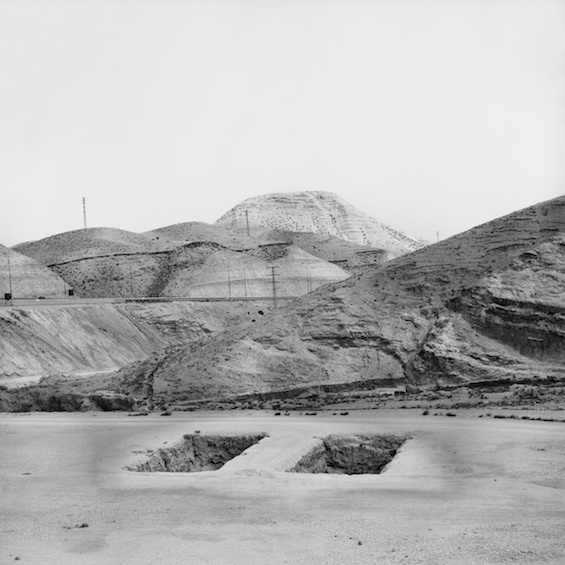Interview with OPEN16 Solo winner Dana Ariel

(above: Holes, 2014, right: Dana Ariel, from Scratches, 2016)
Dana Ariel is the winner of the BPF OPEN16 solo, she was selected to exhibit at Brighton Photo Fringe 2016 from an international open call for photographers. Her exhibition Encountering Perforated Ground will feature new works from her large-scale landscape series taken in Israel and Palestine. Here she discusses the themes and processes that underpin her work with Brighton Photo Fringe Trainee Curator Jamila Prowse...
Jamila Prowse: Encountering Perforated Ground, which is being displayed at this year’s Photo Fringe, tells a story of political erasure and displacement. To what extent does your work deal with wider political narratives?
Dana Ariel: Within the series Sites of Unlearning I visit sites in Germany, the UK, and Estonia as well as Israel and Palestine. It is important for me not to remain in the Israeli-Palestinian conflict, in order for the work to act politically rather than be anchored in a single conflict. As part of my research I bring the different sites together, and although in the exhibition I concentrate mainly on Israel and Palestine, I also included the photo etching book Hainich forest (erased). Hainich is a forest in Germany, close to the borderline between East and West Germany. The forest was flattened to make room for military training, first by the Wehrmacht and later by the Soviets, by creating a grid of tank paths across the area. The histories of Israel and Germany are tied together, and this tie also forms my identity. But that history is not only the story of two countries; it performs as a stain spreading, contaminating, fading over time, and reappearing.
JP: For the project you visited sites in Israel and Palestine. Why did you feel it was important to represent these specific sites, and what do you hope your project communicates to the viewer?
DA: The names of the two sites, the village of Fasa’il and the settlement of Peza’el, originated from the same narrative that split in two. They contradict one another and yet, they reside side by side, both testify for past events, and embody an ongoing conflict in the present. As a site, it is not only concerned with the politics of the region, but also the political use of language, storytelling, and landscape. That, I believe, cannot be represented with a single photograph, or a simple pointing gesture. The photographic work must address the many layers and narratives that create this place, conceptually and visually.
In the exhibition Encountering Perforated Ground I attempt to loosen the ideas of what one might find there. I introduce the unexpected encounters with hospitality when fearing hostility, and the interplay of relationship between soldiers and citizens, state and play, borders and settlements. My visits to these sites are an attempt to unlearn what I am exposed to on a daily basis through the media; to see the graduated colours of the perforated ground, to encounter the contradictions that co-exist side by side, the hostility and the hospitality, and to look closely at the newly formed relationships.
It is important for me to act within a political dimension that is inseparable of life, landscape, and language. To be and to see, are my immediate methods of action.
JP: Rather then focusing on exploring this narrative through portraiture, you have documented landscapes. This approach is typical of your artistic practice. How do you navigate creating emotive work without depending heavily upon portraiture?
DA: When confronted with a portrait it is hard to escape identity, identifying, and being anchored at a particular time and place. In these photographs there is an implied presence of people, the traces of the presence of people - but it remains blurred, and doesn’t lend itself to being immediately identified. The immediate process of identifying is something I attempt to confuse and blur within a methodology of unlearning, in order to slow down the identification process and allow the subtle and complex details to appear and register when encountering both people and landscape.

( Dana Ariel, Amud, 2016)
JP: John Berger in Ways of Seeing explores how seeing comes before words. In Encountering Perforated Ground, you describe the political situation in Israel and Palestine as a ‘crisis of seeing.’ Is this an example of the visual overtaking and preceding language?
DA: Notions of the conflict can be found both in the use of language and ways of seeing. When I spoke of a crisis of seeing I meant it through the lenses of knowledge and sight. For me, it is not a question of one preceding the other, it is how they come into conflict. To visit Fasa’il village and the settlement Peza’el, is to point at the name and the political distinction of village and settlement as what already taint my search. Language and knowledge, in this case, precede seeing and the desire to see that created this exhibition, comes from the need to tamper with prior knowledge and given language. The exhibition is concerned with encountering perforated ground; how one encounters and how can one resist and unlearn in order to encounter without the precedence or over taking of either the visual or language.
JP: Simultaneously, your work explores notions of unseeing and unlearning. How does your position as a photographer engage in these processes? Furthermore, how are these processes inherent in the specific subject matter of the project?
DA: Unseeing begins for me in the photographic act itself. I use a medium format Hasselblad camera and in order to photograph I need to bow my head down to look through the camera at what is in front of me. This is an important gesture that breaks the direct gaze.